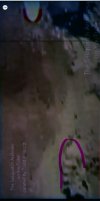IF Gimlin's recollections are correct as recorded:
So then I got on this big horse [Chico], and it weighed 1,200 lbs. With four feet distributing its weight, its tracks didn't go as deep as the tracks of the creature.
Chico is 1,200 # on four feet, that makes 300# per foot right? Not exactly:
The forelimb is complex in the horse, with the head and neck being a crane-like structure that causes 60% of a horse’s body weight distribution to the forelimbs. Therefore, impact is greatest on the front legs (except when pushing off from behind).
Content from External Source
https://thehorse.com/123412/comparing-humans-and-horses/
So more like 720# for the front feet and 480# for the rear, plus 150# or so for Gimlin spread out. Now if Chico walked over to the tracks, at some point he's putting 1/2 his, and Gimlin's weight onto 1 of his front and 1 of his rear feet, the other 2 are moving. So, 720#+ and 480# + on front and rear foot respectively, correct? Or something close?
And Chico's foot (hoof) which is smaller than Bigfoot's foot does not sink into the sand/gravel as much as Bigfoot's does. And yet, he has a much bigger foot to displace the weight than does Chico.
There is a calculation for the Foot Surface Area for human feet from this abstract:
The results show that foot-length and ball-girth are effective estimators of FSA for the total (FSA=1.043 x foot-length x ball-girth, R(2)=95.4%). A test on the necessity of gender-specific formula indicated that no gender-specific formula is needed, and the formula for the total is good for both genders.
Content from External Source
https://pubmed.ncbi.nlm.nih.gov/18937935/
More importantly this is what an average human footprint looks like:

We have an arch, so there is a section of our foot that does not support our weight directly, unlike Bigfoot. As our Soviet Bio-mech expert, as well as Krantz noted:
Lack of an arch may be caused by the great weight of the creature. **
**The above emphasis was Rene Dahinden's...compare this statement with the findings of anthropologists Grover Krantz and of the two Russians, Dmitri Bayanov and Igor Bourtsev in Chapter 9 of Dahinden's book, "Sasquatch" in the 1993 revised edition. Each of these three sources arrived at the same conclusion totally independent of the others.
Content from External Source
http://www.bigfootencounters.com/biology/donskoy1.htm
So, it has huge feet with no arch, meaning the weight can be further spread out, yet it still makes tracks much deeper than a 1200# horse with smaller feet (hooves), according to Gimlin.
Think of it this way, if Chico's 2 front hooves, which are supporting 720# make a track or impression, in the sandy gravel that is say, 1" deep, what happens if Chico then puts his hooves on the Bigfoot sized cutouts (stompers) and spreads the 720# over a much larger area in the same sandy gravel? Does it go even deeper? Quite the opposite, correct? It's the same effect as using snowshoes to spread one's wight out and not sink.
If I'm wrong, and I'm not that good at math so let me know, but it seems we are getting way beyond 500-700# for the creature, giving the size of the foot and the supposed, and almost necessitated, depth of the prints. We're getting into the 1000# range if not more, yet it's still only 6'-6' 6" tall. That just doesn't add up.
Now if they were faked and Patterson didn't think it through and just figured, correctly, that if people saw deep prints, they would assume it was a heavy creature, not realizing it might be way heavier than he thought.



 Ketema Bekele Negasa (ETH)
Ketema Bekele Negasa (ETH)